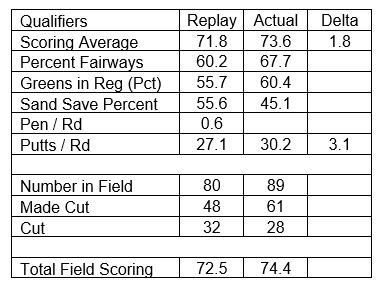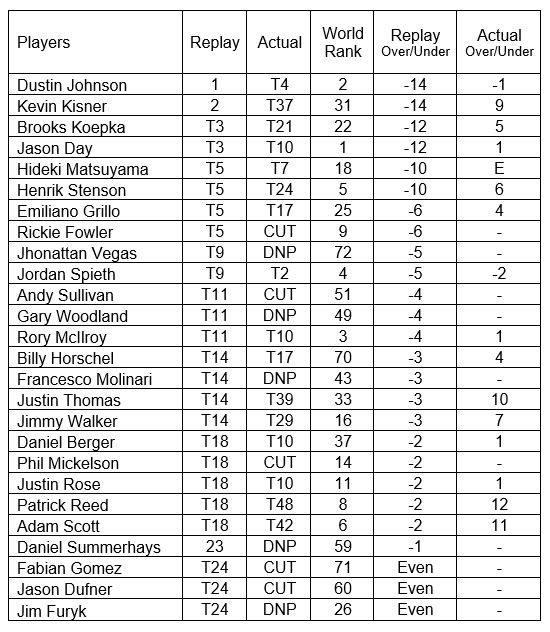The 2016 Masters at Augusta National is often remembered for Jordan’s Spieth’s collapse in the final round. In 2015, Jordan had led wire-to-wire and won. In 2016, Jordan again led after 54 holes, and thus expectations for another Spieth Green Jacket were high.
Conditions at the Masters at Augusta National in 2016 were challenging. Thursday was partly cloudy with a high of 72 with winds WSW at 12 – 16 mph, gusting to 35 mph. By Sunday, the day’s high fell to the mid-60’s and the wind shifted ESE at 6 – 12 mph. Morning (~8 AM) temperatures all four days were in the high 30’s to low 40’s.
Known for its beautiful Azaleas and manicured fairways and greens, in 2016 Augusta National presented the field with cooler, windy conditions and scores aligned accordingly. Only six players broke par with Danny Willett taking it all at 5 under par. Lee Westwood and Jordan Spieth finished second, tied at 2 under.
Wind and Course Conditions
The Day Wind and Course Conditions for the Magnolia replay were determined by dice roll:
Day 1 – Moderate / Normal
Day 2 – Calm / Soft
Day 3 – Blustery / Dry
Day 4 – Moderate / Firm
While APBA Golf has no temperature adjustment effect, the replay and actual day winds were comparable on average across the 4-day period. Pin positions for the replay were 2, 1, 3, and 5.
Both Augusta National and Magnolia played at about 7,400 yards to a par of 72. The replay employed the full set of Master game and optional rules. The replay used the entire 80-card 2016 set of player cards. Fifty-four players in that set played in the actual event. The tournament used the ‘rule of 10’ to establish the cut line—i.e., within 10 shots of the leader.
Strategy
The typical strategy off the tee was ‘grip-it-and-rip-it’, and around the greens it involved ‘pin seeking’ as much as possible. Magnolia’s greens are large and most feature fairways on all sides of the green with a modest number of traps and no ‘deep’ bunkers.
The long par 4, No. 11, is an exception in that the pond that lies next to the left side of the green suggests layups and bail outs to the right of the green. Also, water on both back nine par 3’s requires a bit of caution with certain pin placements. Unless long off the tee and right of the centerline on No.15, laying up to a good angle to attack the green on that water-protected par 5 makes good sense as well.
For most of the other holes, pin placements well off the centerline meant ‘go-for-it’, even if that involved working the ball to the pin. Experienced game players know that working the ball results in considerable variation and in all too frequent double crosses—i.e., shooting in one direction but going in the other. Nevertheless, with no serious penalty for those bad outcomes, being within 20 yards of the pin or even on the pin proved worth the risk. Also, with little to no rough, putting from ‘off the green’, when close to the pin from the fairway, was a good strategy.
Actual vs. Replay Results
In the actual event, the players struggled. The total field averaged 74.4 strokes per round, with the qualifiers at 73.6 strokes per round. Qualifiers averaged 30.2 putts per round.
The field for the replay qualifiers just broke par with an average of 71.8 strokes per round. The single biggest difference between replay and the actual event was in putting, which favored the replay qualifiers by 3.1 strokes per round.
While the actual players were more accurate off the tee and hit more greens, the replay group had better short game results. That included better play from greenside bunkers, which led to fewer putts. The results are summarized in the table below:

At the end of 72 holes in the replay, Dustin Johnson parred to beat Kevin Kisner in a one-hole playoff (on No. 18). Both finished regulation play at 14 under par. Kisner reached 14 under by playing consistently, hitting greens and putting well. Meanwhile, Johnson closed Day 4 with a tournament-low score of 65 and led all players in putting at 24.4 putts per round.
Right behind the leaders were Brooks Koepka and Jason Day at 12 under. Of the top ten world-ranked players, only Alex Noren and Bubba Watson did not finish par or better. (Noren did not play in the actual event.) On the other hand, neither Danny Willett nor Lee Westwood made the replay’s cut. Jordan Spieth in the replay did finish tied for 9th at 5 under.
A comparison of the results for top replay finishers to their actual results is provided in the table below:

Background on the Replay
The replay began in January of 2019 and finished in the early fall of that same year. The Masters replay was the first event that used the Game Caddie tool. In fact, it was created during the playing of this tournament and evolved accordingly.
The math and course management demands that came with playing 3 or 4 players at a time, under the full set of Master Game rules, called for a way to simplify and expedite the process of play. In addition, the creation of the many in-game statistics called for a way to collect and display them. While the pace of this tournament was slowed during development of the new tool, that effort paved the way for other events.
The end result is the Game Caddie, an Excel workbook that makes the math more manageable and thus allows the focus to shift from in-game calculations to golf strategy. The Access database tool that manages tournament reports, the Game Caddie Record Book, did not exist at the time of this tournament.